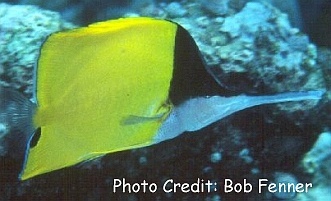
By Bob Goemans

Likely Reef Tank Suitable
Likely Fish-Only Tank Suitable
Range: Western and Central Pacific Ocean: East Africa/Mozambique east to the Hawaiian Islands, north to Southern Japan, and south to New Caledonia and Austral Islands.
Size: 8.5 inches (22 cm)
Natural Environment: This widespread species inhabits outer seaward reefs having abundant coral growths, numerous caves and ledges. Feeds on crabs, small crustaceans, and worms at depths between 10 to about 660 feet (3 – 200 m), yet mostly collected at about 50 feet (15 m).
General Husbandry: This attractive species is similar in coloration to F. flavissimus, as it also has a brightly colored yellow body with its upper face area black with the lower half off-white. It’s dorsal, anal and pelvic fins are also yellow, with the tail and pectoral fins clear. There’s also a black false eyespot on the upper aft edge of the anal fin, but only this species has a patch of dark spots on the chest. Its biggest attraction is also its elongated, needle-nose-like snout, which is silghtly longer than that on F. flavissimus, hence the name ‘Big’ Long-nose Butterflyfish. Regrettably, its mouth is somewhat smaller!
Usually adapts fairly easily in larger reef style aquariums or peaceful fish-only community aquariums, especially those with lots a rocky caves and ledges to explore. A meaty diet, e.g., live fortified brine shrimp, black worms (Lumbriculus variegatus), and/or various frozen meaty foods such as mysis are usually eagerly accepted and should be offered several times daily. Because of its small mouth, foods need to be finely shredded.
Often a great addition to most reef aquariums because its natural diet consists mostly of very tiny crustaceans, thereby not a threat to most SPS, LPS and soft corals. It’s also a good consumer of Aiptasia anemones, however its appetite for them declines if supplied more suitable/preferred foods. It may also consume small decorative tubeworms and other useful small worms.
Even though usually quite easy to get feeding, should there be some difficulty, recommend supplying it small human consumption clams/black mussels purchased in local grocery stores and placed on the half-shell in the aquarium where it can pick on its contents/help entice it to begin feeding. Over time, frozen foods like mysis and brine shrimp will be more readily accepted.
This is one of the more distinctive species of butterflyfishes and difficult to confuse with others in its family.
Taxonomy:
Order: Perciformes
Suborder: Percoidei
Family: Chaetodontidae
Genus: Forcipiger
FYI: There’s also an overall darkish brown phase, possibly a seasonal occurrence that has been seen in Hawaiian waters, then changes in captivity to its more recognizable yellow form.
Preferably maintained without others in the same genus, except as a male-female pair, as they can become quite territorial and battle others for territorial rights.
Pressing some soft foods into openings/crevices on a piece of old dead coral skeleton can sometimes encourage finicky eaters to begin feeding.
Experience Level: Intermediate
Temperament: Peaceful
Diet: Carnivore
Coral Safe: Caution advised
Invertebrate Safe: Caution advised
Acclimation Time: 30 minutes+
Aquarium Environment: Reef aquarium (see above) and fish-only aquarium.
Tankmates: Peaceful or non-aggressive
Minimum Tank Size: 75 gallons
Temperature Range: 70 - 82°F (21 – 27°C).
Specific Gravity: 1.020-1.026
pH: 8.0 - 8.5
